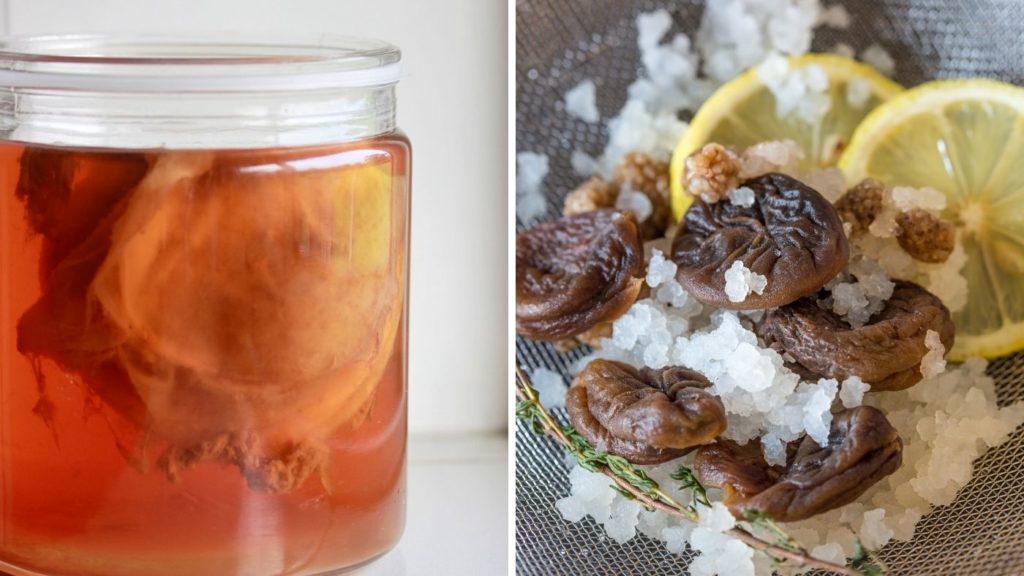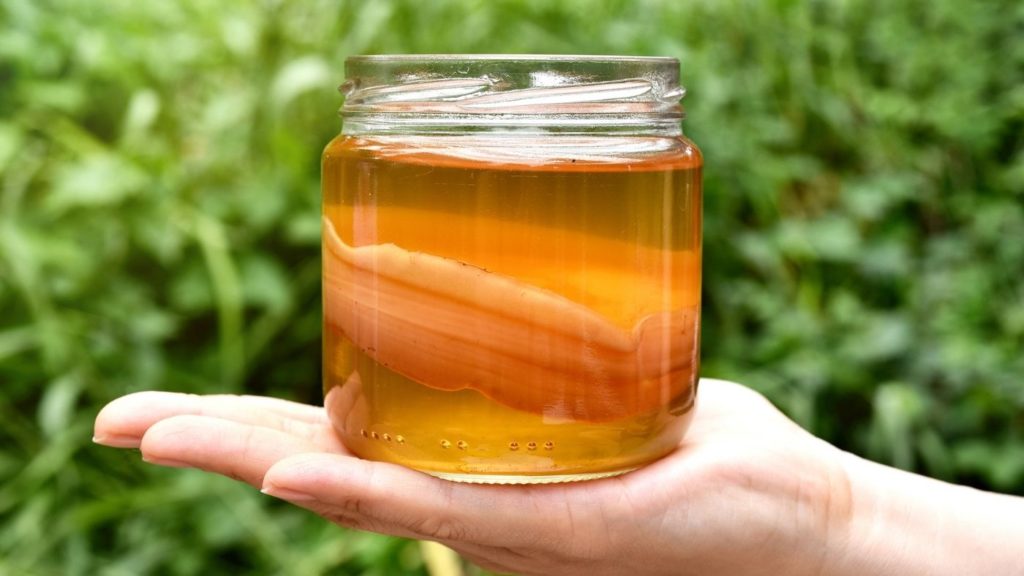Eating local is something we value a lot at Revolution Fermentation.
So, we challenged ourselves to create a 100% Canadian kombucha recipe. Through trial and error, we managed to develop a delicious locavore kombucha recipe, just for you!
Kombucha is a fermented drink that originated in Asia. The microorganisms in the kombucha scoby developed by drinking sweetened tea.
Even today, kombucha is prepared with 4 main ingredients: water, kombucha scoby, tea, and sugar.
The first two are easily found in North America. However, tea and sugar are not from here. So we did a lot of testing (see notes at the end of the article!) to find local ingredients to replace them.
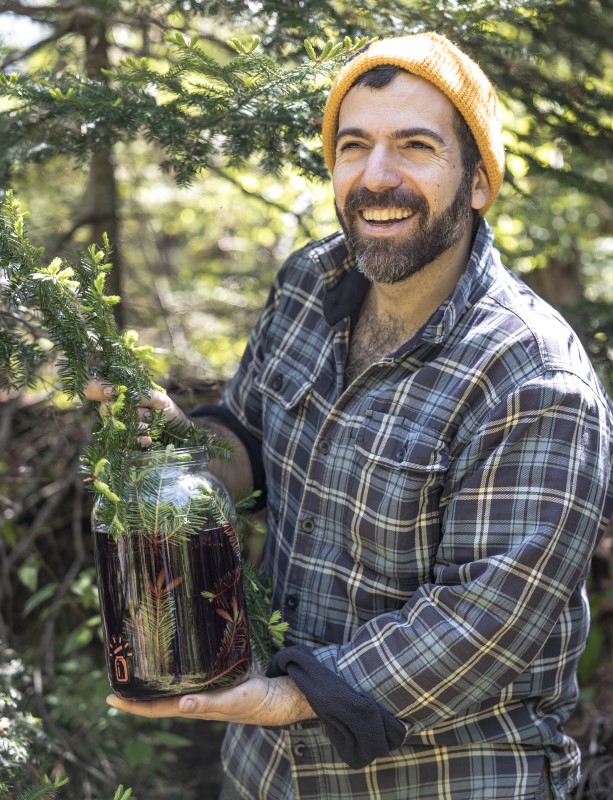
This article provides you with the results of our research, as well as a recipe for 100% local balsam fir kombucha.
Go directly to the relevant section:
- What is the local alternative to sugar?
- What is the local alternative to tea?
- Flavouring with local plants
- Recipe for 100% Canadian balsam fir kombucha
Which Local Sugar to Make Kombucha?
The bacteria and yeast in kombucha mainly feed on sugar. Without sugar, there is no fermentation!
Cane sugar, while perfect for making kombucha, is not produced in Canada.
Two local sources of sugar are perfect for our local kombucha project: maple syrup and honey.
Making Kombucha With Maple Syrup
Maple syrup contains enough sugar to replace cane sugar in kombucha.
Use the same volume of maple syrup as sugar, i.e. between ¼ and ⅓ cup of syrup per litre of tea (please note that this is their volume; their weight is not the same).
Note: Maple flavour will weaken during fermentation. If you are looking for a real maple taste, check out our maple kombucha recipe to learn how to bring out the maple flavour.
Making Kombucha With Honey
Honey is an excellent source of sugar for kombucha. The sugar in honey gives the drink a more delicate and rounded flavour profile.
However, a kombucha scoby may have a hard time eating the honey. It is best to turn to jun scoby, a kombucha culture suitable for honey fermentation.
For more information, see our jun recipe.
What Is the Local Alternative to Tea for Making Kombucha?
Tea is an essential source of nutrients for microorganisms in kombucha. Yeast and bacteria are stimulated by the tannins and nitrogen compounds found in tea.
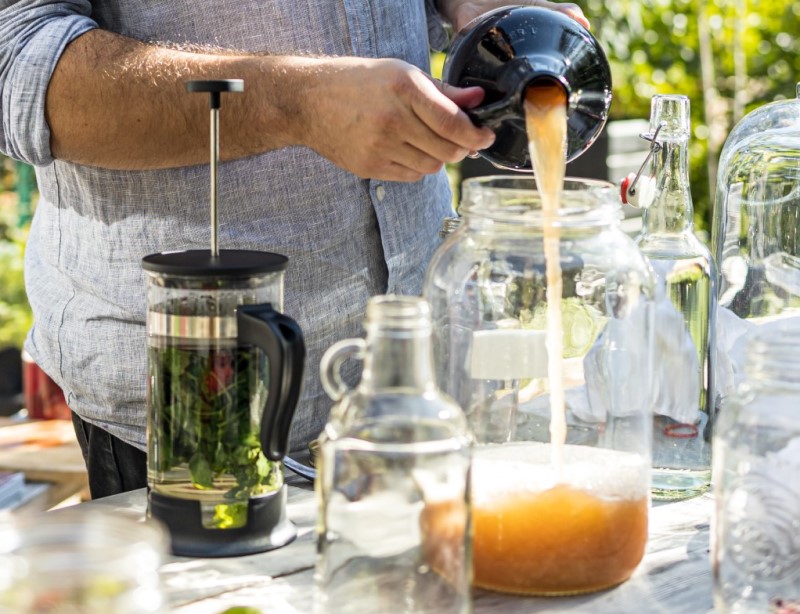
According to our tests, raspberry leaves, sea buckthorn leaves, and fireweed tea contain enough nutrients to promote kombucha production. The advantage of these plants is that they grow in abundance in Canada!
However, these three plants contain less tannin than tea. Therefore, you need to double the quantity and brew it longer in order to extract more nutrients.
Raspberry Leaves
Raspberry (Rubus idaeus L.) is a hardy, indigenous plant known for its herbal properties. The leaves are used in infusions.
- Quantity: 9g (1 cup) per litre of kombucha
- Infusion time: 30 minutes
Sea Buckthorn Leaves
Sea Buckthorn (Hippophae rhamnoides L.) is a hardy shrub grown in Canada for its fruit which is exceptionally rich in vitamin C. Its leaves, also highly beneficial from a health perspective, can likewise be used in infusions.
- Quantity: 9g (½ cup) per litre of kombucha
- Brewing time: 30 minutes
Fireweed Leaves
Fireweed (Epilobium angustifolium) is a native and hardy plant. Just like tea, its leaves are oxidized before they are dried.
- Quantity: 12g (⅓ cup) per litre of kombucha
- Brewing time: 30 minutes
To learn more about tea’s purpose in kombucha, have a look at Which tea to choose for your kombucha?
How to Flavour Your Kombucha With Local Plants?
Now that we have all the ingredients to make 100% local plain kombucha, we just need to flavour it!
Canada’s forests abound with local ingredients full of flavour. To concoct your own local kombucha, look for conifers, berries, flowers, and all sorts of indigenous plants.
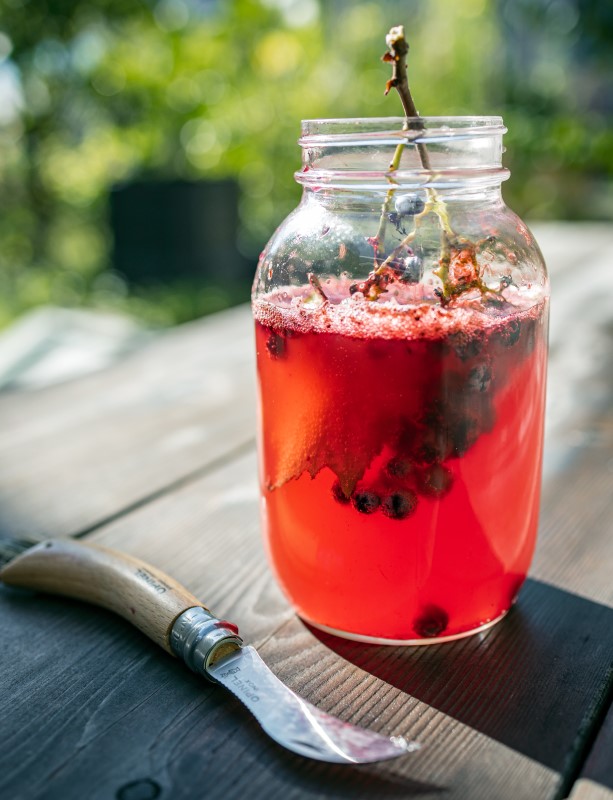
Honey and maple syrup can also be used to add flavour during the second fermentation. This way, they provide even more taste, and not only during the first fermentation.
Our favourite ingredients for flavouring kombucha with local tastes are:
- Chaga and honey
- Balsam fir buds
- Wild blueberries and sea buckthorn berries
- White cedar
- Hops
- And much more!
For more local flavours, check out How to Flavour Fermented Beverages with Local Plants.
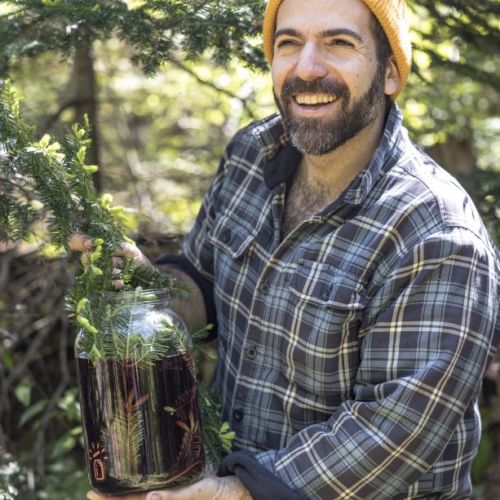
100% Local Canadian Kombucha Recipe
Ingredients
- 1 kombucha scoby and its liquid culture about 500 ml (2 cups)
- 24 g raspberry leaves
- 270 g maple syrup
- 3 L water
- 8 g balsam fir tips
Steps
- Place the raspberry leaves in a saucepan and add 500ml of boiling water.
- Let it infuse for 30 minutes, then strain and pour the infusion into the jar.
- Add the maple syrup and stir until dissolved.
- Add 2.5 litres of cold water.
- Add the kombucha scoby and its liquid culture.
- Cover the opening with the cloth and the rubber band.
- Let it ferment for 10 to 15 days at room temperature. Start tasting as of the 5th day. As soon as it is to your liking, put aside in the fridge 500ml of kombucha and the scoby for your next kombucha fermentation.
- Add the balsam fir tips to the jar and let it infuse for 24 hours in the fridge.
- Filter and bottle.
- Leave the bottles at room temperature, testing the pressure each day by opening the bottles.
- Put in the fridge once it's fizzy (beware of the pressure!).
Notes
Notes on Our Tests
To make our 100% local kombucha, we tested several types of local plants. Raspberry leaves, sea buckthorn leaves and fireweed tea stood out in our experiments.
For each test, we always used the same amount of water and kombucha scoby. The plants, the sugar used, and the proportions varied from test to test.
To see if a kombucha fermentation was doing well, we observed three main criteria:
- The formation of the scoby
- The amount of sugar remaining
- The acidity created during fermentation
To make traditional kombucha, you need to use about 4g of tea per litre. However, the local plants that were tested contain less tannin than tea.
To extract enough nutrients, we tested different amounts of plants and infused them for longer periods. We found that, depending on the plant, between 9 and 12g per litre gave excellent results.
In every recipe, we infused the dried plants in water at 90°C for 30 minutes.
Are you curious and would you like to try other local plants? Feel free to experiment with nettle, verbena, lemon balm… Have fun! However, we advise you to keep a “plain” kombucha scoby, in case your tests are not conclusive.
